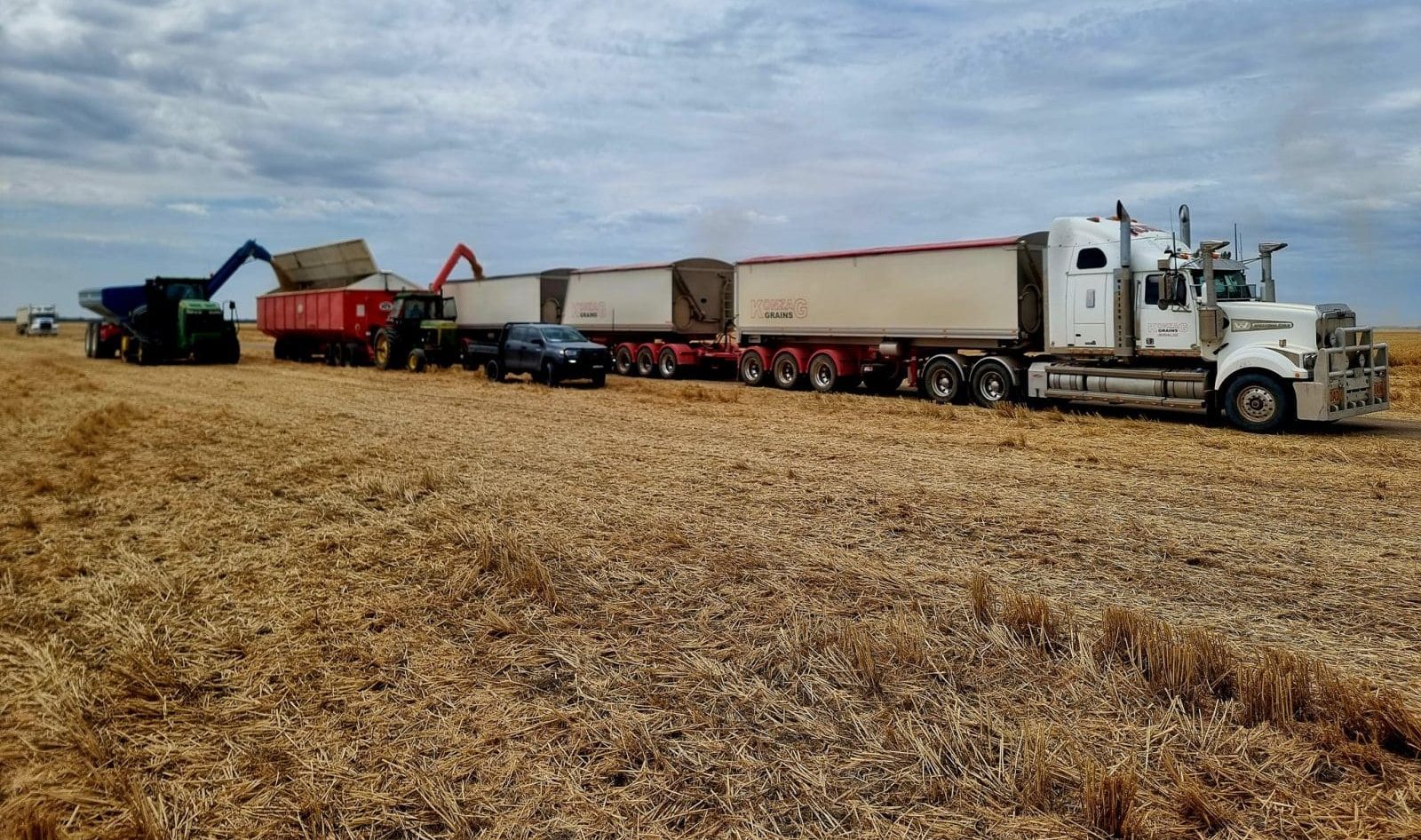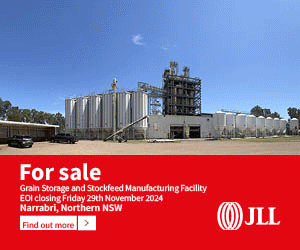
Moving wheat at Walgett, where a bumper harvest is fast drawing to a close and yields in many cases exceed a well above-average 5t/ha. Photo: Ryan Konzag
PRICES for wheat and barley in the northern region have shot up by $30 per tonne or more as consumers feel the pain of the grower’s focus on selling and shifting pulses straight off the header.
Some heavy rain in parts of southern Queensland, and generally lighter and patchier falls in northern New South Wales, have further strengthened bids from some northern consumers.
Prices in the south have also rallied to reflect the southern grower’s focus on selling and delivering canola, and an expected early run on lentil sales once the Victorian harvest ramps up.
Prompt export interest in wheat and barley is reasonably thin, as canola in the south and pulses in the north muscles in on early new-crop slots.
| Prompt | Nov 7 | Jan fwd | Nov 7 | |
| Barley Downs | $322 | $285 | $322 | $310 |
| ASW Downs | $340 | $310 | $338 | $318 |
| Sorghum Downs | $332 | $325 | $325 Mar | $325 |
| Barley Melbourne | $330 | $312 | $330 | $312 |
| ASW Melbourne | $355 | $335 | $355 | $335 |
Table 1: Indicative prices in Australian dollars per tonne.
Rain slows north
Patchy rain in recent days has delivered some big registrations to Qld locations including: Jondaryan 37mm; Felton 72mm; Macalister 51mm; and Surat 45mm.
 Most growers on the Western Downs have finished harvest, or are close to it, and the rain has been ideal for sorghum crops which will hit the bins in February-March.
Most growers on the Western Downs have finished harvest, or are close to it, and the rain has been ideal for sorghum crops which will hit the bins in February-March.
In northern NSW, falls were much lighter, and included: Dubbo 11mm; Gunnedah 5mm; Moree 12mm; Quirindi 8mm, and Walgett 2mm.
Rain has paused harvest at many farms, where some yields have been the best ever, and included wheat at 7t/ha, and chickpeas at 6t/ha.
Growers continue to focus on out-turning chickpeas and faba beans to export vessels loading in coming weeks, with the task occupying just about all of the trucks working longer hauls.
“The chickpea growers and traders can pay an extra $5-$10/t for freight, so traders locked into feedlots are…trying to execute around that,” Smithfield Cattle Co commodity buyer Brett Carsburg said.
“It’s dragged every truck available from coarse grains into pulses.
“Feedlots aren’t seeing the grain coming in.”
At Walgett, Outlook Ag director Greg Rummery said the wheat harvest has been what was needed after dry conditions saw very little planted last year, and rain and flooding impacted the year before.
Mr Rummery said Walgett’s harvest has been “by and large outstanding”.
“Cereals have been phenomenal, with fertiliser put on to maximise yield, and to get protein; a lot will average 5t/ha or better,” Mr Rummery said.
Northern NSW’s highest wheat yields so far are coming in at 7t/ha, and many, even west of the Newell Highway, have achieved 6t/ha.
Because of the big volumes being harvested, a large number of growers in northern and central NSW are storing cereals in bunkers, grain bags, or silos at home, and will either deliver to a buyer or into warehousing once the pulse task is over.
Southern growers sell canola
In southern NSW and northern Victoria, growers are harvesting, selling and delivering canola, and showing little interest in pricing barley, which has created some shorts in the market.
On wheat, flour mills are buying from around the West Wyalong district and points north, above the line where frost is expected to have created widespread screenings issues.
At Young, Grain Focus managing director Michael Jones said delivered barley prices were generally $20-$30/t above those offered at bulk-handling sites, and southern NSW consumers have been booking volume at around $280/t.
Getting the lion’s share of action has been canola, which has traded at up to $810/t delivered Port Kembla for prompt export.
Mr Jones said current bids for canola and barley are giving growers very clear signals: “Sell all the canola you can at these numbers; with barley, hold it as much as you can.
“Lots of canola is selling.
“In the north it’s chickpeas, in the south it’s canola; after that, we’ll see what we do with the wheat.”
Fuelling the strong bids has been the impact of frost on canola in the southern half of NSW, which has seen domestic crushers bid up to get the volume and quality they need.
Mr Jones said consumers generally are comfortable that plenty of feed wheat and barley will be available delivered for less than $300/t, compared with around $400/t last harvest, and a number of them in southern NSW have filled their November requirements.
In Victoria, Riordan Grain Services chief commercial officer Mark Lewis said barley yields have been “surprisingly good” in the Mallee.
Anecdotes of crops yielding 2.5t/ha and grown on only 100-mm of in-crop rain are encouraging, and Mr Lewis said the quality of Vic’s barley coming in has been “fantastic”.
With Western and South Australia expected to be light on for malting due to their generally tough seasons, any malting barley harvested in Vic is likely to be malted locally or exported, which will maintain malting’s premium over feed to keep it out of the feedgrain market.
Grain Central: Get our free news straight to your inbox – Click here